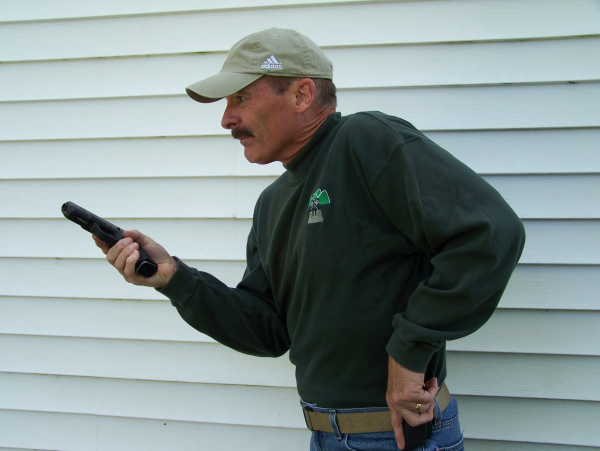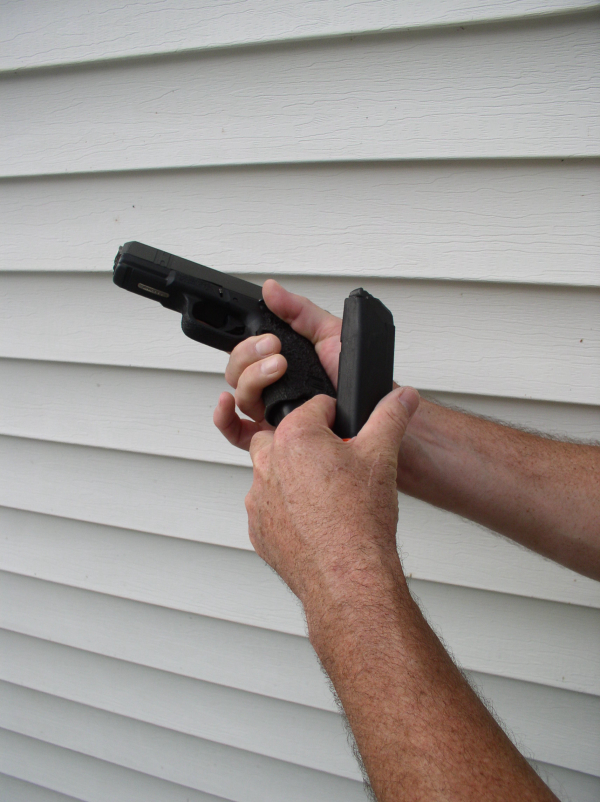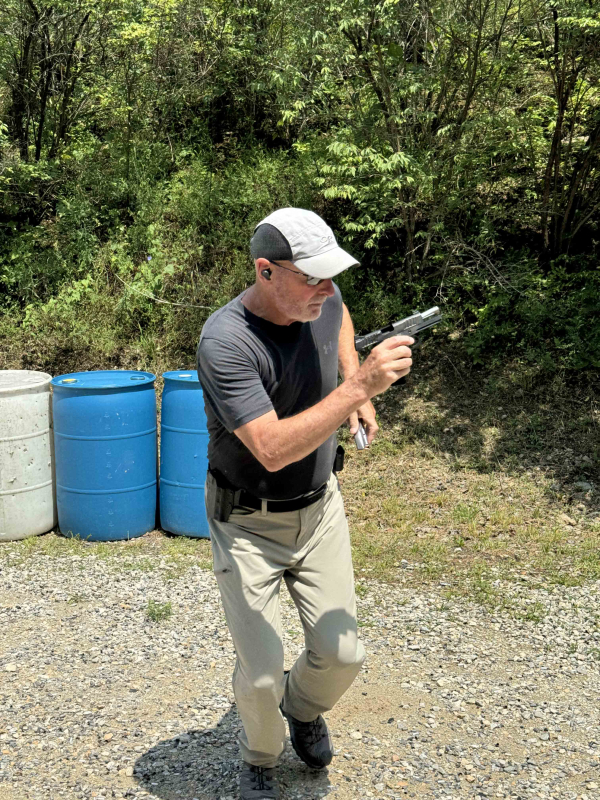Today’s feature is from correspondent Dave Spaulding.
Reloading a semi-automatic pistol is not complex unless you have to do it fast. Speed comes into play in three circumstances: the practice timer, competition and combat. I once heard a famous instructor say “competition offers the same level of stress as a gunfight,” but I’m not sure I buy it. First, I think it is more duress than stress and second, having bullets whizz past your head is like no other sensation.
Serious shooters know how difficult a FAST reload can be. The hands don’t work normally, the fingers fumble and magazines don’t align with the grip quite as smoothly as they do slowly. Now add someone trying to take your life while you are likely moving, yelling and lacking motor function and you will understand why reloading needs to be as simple as possible.
What is combat stress? It’s the physical/psychological phenomenon occurring when our brain perceives danger and prepares the body for action. Simply, sensory nerves pass danger perception to the hypothalamus which in turn transmits a signal to the pituitary gland. This gland releases a chemical messenger into the bloodstream while the hypothalamus transmits a nerve signal down the spinal cord. Both will arrive at the adrenal gland resulting in the release of epinephrine into the blood stream. Cortisol is also released resulting in increased blood pressure and sugar levels suppression of the immune system. Also known as adrenaline, epinephrine is an efficient messenger that gets the heart beating faster so the body is ready for hard physical activity. Simultaneously, the brain stem releases norepinephrine that travels throughout the body all of which create an increase in circulation and energy to certainly body systems and a downshift of less important ones into a maintenance mode where they function but not at the unstressed level.

This is why people involved in combat lose digital dexterity in which the fingers do not function as well as they normally do. The fingers will perform but will have greater difficulty performing tasks they have not practiced thoroughly. What many call “muscle memory” is really “familiar task transference.” When practiced to this level, most any skill can be performed, even under extreme duress, when the chemical reaction of the body might be working against them, but it takes time and effort to develop. Any skill does.
While interesting, you might wonder what this has to do with pistol reloading? Reloading a pistol quickly is a complex motor skill, requiring both fine and gross muscle movements to work together and it is the fine motor skills that diminish when someone is trying to harm you. That said, there is good news. In the age of high-capacity pistols, reloading in a pistol fight seldom happens. If it does it’s a dire situation and not something you want to leave to chance. Confidence is a product of skill; it’s important to have both.
What I am going to say next will certainly fire up a few folks, but I do so in the interest of public safety: if possible, don’t shoot your gun dry. Currently, it is common in combative shooting courses to practice nothing but slide locked reloads, the emergency reload, as the argument is “You might as well shoot the gun dry in training as that is what you are going to do in a fight” and while this might be likely, is it wise to train to make it inevitable? Slide lock is a really bad time to reload, especially if your opponent sees it. Exchanging magazines quickly is difficult enough but now add the time/effort to release the slide. Also, the emergency reload is unexpected, so recognition time will also be a big factor. Add to this the possibility of automatically “tap-racking” when the pistol goes “click.”
What happens if, during the fight, the slide does not lock open after the last round fired? Maybe your shooting hand thumb was resting on the slide stop. You might be pressing the trigger on an empty gun as your only load stimulus failed, resulting in lag time. Consider an empty gun the same as a useless gun, so let’s load when we can and not when we have to. By merely changing magazines we make the task less complicated and faster to get to a fully loaded condition. But why would you drop perfectly good ammo on the ground? You might need it.
Think about this: You have been engaged in a firefight and expended an unknown number of rounds. Your attacker is moving, maybe trying to flank you and you have no idea what is coming next. Would this be a good time to reload quickly - or try to save ammo by performing a dexterity challenging “tactical reload?” By performing a speed reload I now know I have 16 rounds in my Glock 19. How many rounds did I eject to the ground? In the thick of the fight, how could I know? I have no idea how much time I have to reload in that event. Maybe I could retrieve this magazine at some point.
I’d recommend that you never give up a known for an unknown. Of course, this is all moot if you do not have a spare magazine.

Any time you add something to something you will increase the time it takes to accomplish the skill. Sure, you can practice to reduce the overall time, but it will still take longer. Dropping the slide on a semi-auto adds time. Never mind that the process is controversial in the shooting community. Some advocate a “power stroke” where the shooter comes up and over the slide, grasping it with a cupped hand, and then pulling back vigorously, actually hitting himself in the shoulder, ensuring “complete slide retraction” according to its advocates. It’s excessive considering the slide only has to move a quarter inch or so to be released and full recoil spring compression occurs shortly thereafter. In addition, the shooting and support hand end up far apart, adding time to rebuilding your grip. At the other end of the argument are the competition-based shooters who advocate using the shooting hand thumb to drop the slide, which is certainly the fastest method. The downside is the thumb is being tasked with multiple functions in a very short period of time (hitting both the magazine release and the slide lever) and if the timing is off just slightly, the shooter could end up with an empty gun.
I have seen shooters drop the slide before the magazine is fully inserted on many, many occasions, resulting in a dead trigger followed by a “tap –rack” which slows the shooting response even further.
If using the slide lever, consider using the support hand thumb to push down. This adds a few 1/10ths of a second, but ensures the magazine is seated first. If an overhand grip is preferred, how about releasing the support hand, turning the slide into the hand, pull back like pulling on a rope enough to release it, upright the gun and then re-grip the pistol? It’s just as sure and simplifies the process.
Okay, at this point you might be thinking that loading when you want to and not when you have to sounds like a good idea, provided you carry a spare magazine. The harsh reality is many shooters do not have the presence of mind to do it. The fact of the matter is, students of combative pistolcraft shoot their pistols dry. I fought it for decades but gave up. I realized the time spent trying to introduce the speed load was wasted and I could be using it for other skill introduction and development. Students paid good money for my courses and I owed them as much as I could offer. Why waste time on something students just will not do?

Forget high duress events, students continually shoot their pistols dry even during low stress, introductory drills. Students from my classes will tell you I would continually walk the firing line offering the admonition, “there is no requirement to run your gun dry” or “it is perfectly acceptable to top off your gun as you see fit’” but students just didn’t do it. What really surprised me was the number of folks who would step up to the firing line to complete a known round count drill and not have enough ammo in their gun to complete it! Often they would say, “I meant to do that…I wanted to push myself through an emergency reload under stress.” I guess it sounds better than saying “I was not paying attention.”
Besides, if you know the reload is coming, there is no real “stress.”
Training, like many things in combative pistolcraft, is the answer but I can’t help but think we are making a mistake when it comes to when to reload. Currently, there is a movement in the training community to not practice reloads at all. “They seldom happen in real gunfights, so why bother?” Some trainers even advocate dispensing with the spare magazine. If the slide lock reload is a reality and it’s the only time folks will “feed” their pistol, then we need to work hard to execute them well. It only takes one person dying on video, due to lack of reloading skill (or not having a spare magazine) to turn the training industry upside down.
This message will be unpopular in some circles, I’m messing with their chosen reality. No worries, just ignore this. I’m an old “Fudd” and don’t know what I’m talking about anyway.
— Dave Spaulding